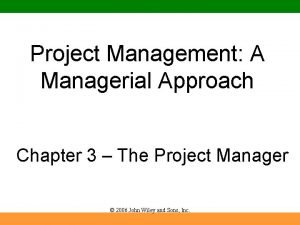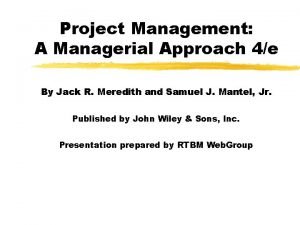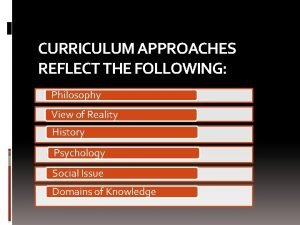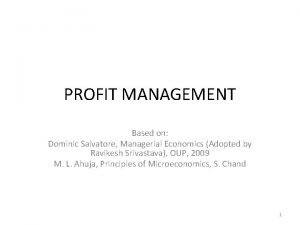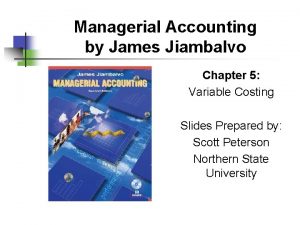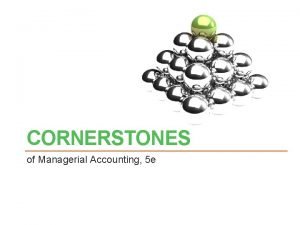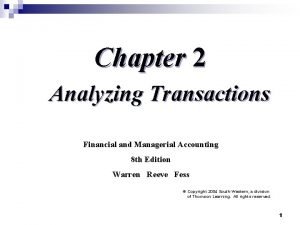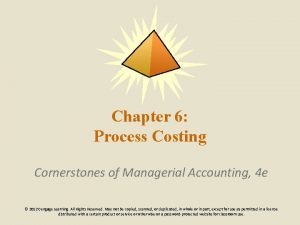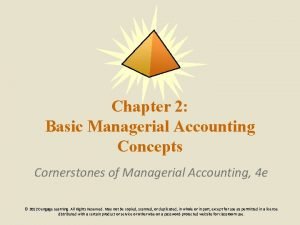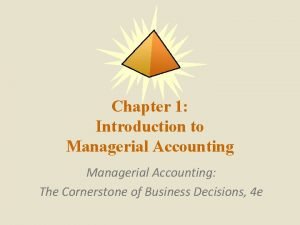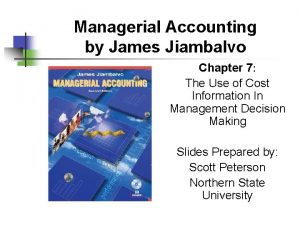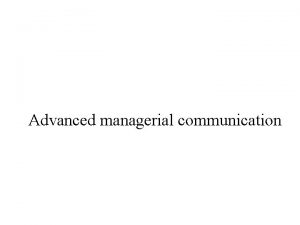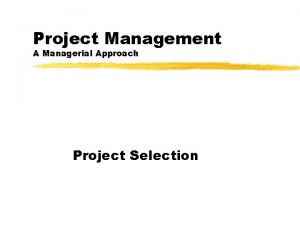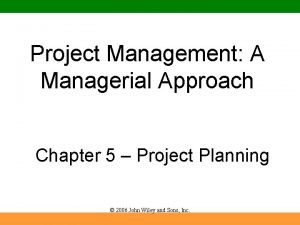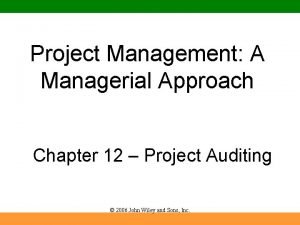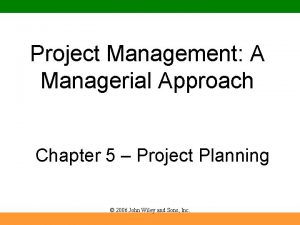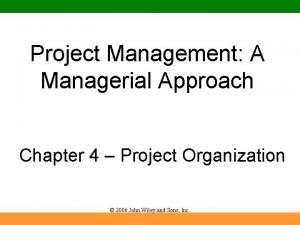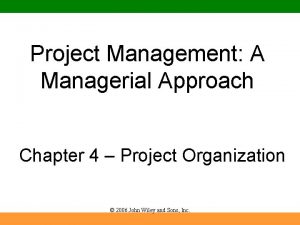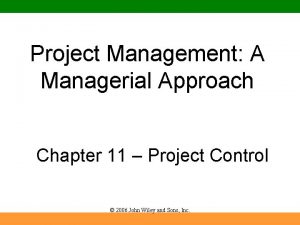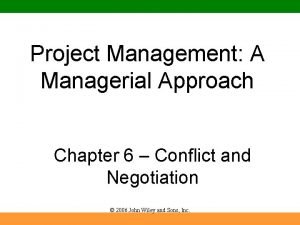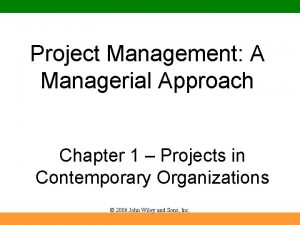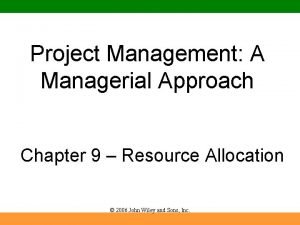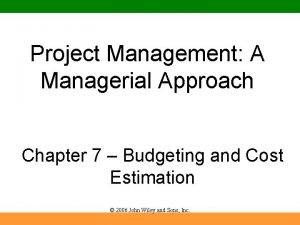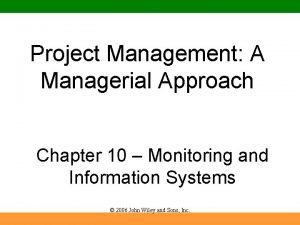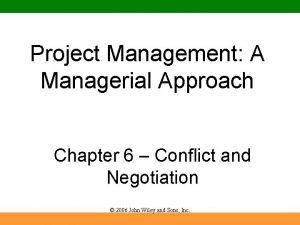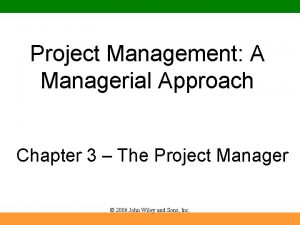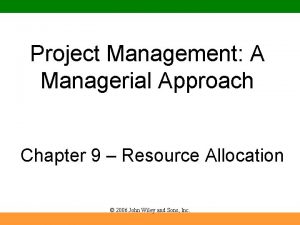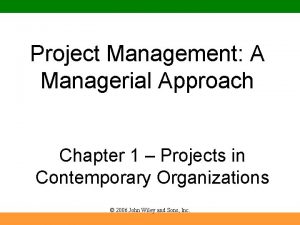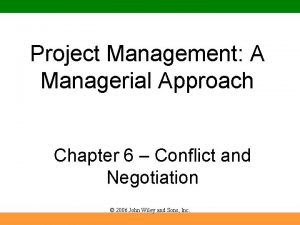Project Management A Managerial Approach Chapter 3 The





































- Slides: 37

Project Management: A Managerial Approach Chapter 3 – The Project Manager © 2006 John Wiley and Sons, Inc.

Overview • • • PMs and Organizational Alignment Key PM Responsibilities Career Management PM “Realities” PM Selection PM Considerations © 2006 John Wiley and Sons, Inc.

Project Management and the Project Manager • The Functional Manager vs. The Project Manager – Functional managers are usually specialists, analytically oriented and they know the details of each operation for which they are responsible – Project managers must be generalists that can oversee many functional areas and have the ability to put the pieces of a task together to form a coherent whole © 2006 John Wiley and Sons, Inc.

Functional Manager and the PM • The Functional Manager – Analytical Approach – Direct, technical supervisor • The Project Manager – Systems Approach – Facilitator and generalist © 2006 John Wiley and Sons, Inc.

Organizations and Functional Manager • The Functional Manager © 2006 John Wiley and Sons, Inc.

Project Management and the PM • The PM © 2006 John Wiley and Sons, Inc.

Project Management and the PM • Major questions face the PM: – 1. What needs to be done? – 2. When must it be done? – 3. How are the resources required to do this job going to be obtained? • PM is responsible for organizing, staffing, budgeting, directing, planning, and controlling the project. © 2006 John Wiley and Sons, Inc.

Responsibilities of a PM • Responsibility to the Parent Organization • Responsibility to the Client • Responsibility to the Team Members • Above all, the PM must never allow senior management to be surprised—be prepared to give “bad news” © 2006 John Wiley and Sons, Inc.

Responsibilities to the Parent Organization • • • Conservation of resources Timely and accurate project communications Careful, competent management of the project Protect the firm from high risk Accurate reporting of project status with regard to budget and schedule © 2006 John Wiley and Sons, Inc.

Responsibilities of the PM • Responsibility to the Client – Preserve integrity of project and client – Resolve conflict among interested parties – Ensure performance, budgets, and deadlines are met • Responsibility to project team members – Fairness, consistency, respect, honesty – Concern for members’ future after project © 2006 John Wiley and Sons, Inc.

Project Management Career Paths • Most Project Managers get their training in one or more of three ways: – On-the-job – Project management seminars and workshops – Active participation in the programs of the local chapters of the Project Management Institute – Formal education in degree/certificate programs © 2006 John Wiley and Sons, Inc.

Project Management Experience • Experience as a PM serves to teach the importance of: – – An organized plan for reaching an objective Negotiation with one’s co-workers Follow through Sensitivity to the political realities of organizational life • Careers often starts with participation in small into larger projects, until given control over small, then larger projects © 2006 John Wiley and Sons, Inc.

Special Demands on the PM • A number of demands are critical to the management of projects: – Acquiring sufficient resources – Acquiring and inspiring personnel • Finding sources of internal motivation – – – Dealing with obstacles Making project goal trade offs Dealing with risk and failure (perceived or otherwise) Maintaining multiple channels of communication Negotiation © 2006 John Wiley and Sons, Inc.

Acquiring Sufficient Resources • Resources initially budgeted for projects are frequently inadequate – Sometimes resource trade-offs are required – Subcontracting is an option – Project and functional managers perceive availability of resources to be strictly limited – Competition for resources CAN turn into “win-lose” propositions between project and functional managers © 2006 John Wiley and Sons, Inc.

Acquiring and Inspiring Personnel • A major problem for the PM is that most people required for a project must be “borrowed” – At times, functional managers may become jealous if they perceive a project as more glamorous than their own functional area – Typically, the functional manager retains control of personnel evaluation, salary, and promotion for those people lent out to projects – Because the functional manager controls pay and promotion, the PM cannot promise much beyond the challenge of the work itself – Violation of “Unity of Command” principle © 2006 John Wiley and Sons, Inc.

Attracting the “Best” Team • Characteristics of effective team members: – High quality technical skills – Political sensitivity – Strong problem orientation – Strong goal orientation – High self-esteem © 2006 John Wiley and Sons, Inc.

Dealing with Obstacles • One characteristic of any project is its uniqueness and with that come a series of crises: – At the inception of a project, the “fires” tend to be associated with resources – As a project nears completion, obstacles tend to be clustered around two key issues: • Last minute schedule and technical changes • Uncertainty surrounding what happens to members of the project team when the project is completed © 2006 John Wiley and Sons, Inc.

Making Project Goal Trade-offs • The PM must make trade offs between the project goals of cost, time and performance – During the design or formation stage of the project life cycle, there is no significant difference in the importance PM’s place on the three goals – Schedule is the primary goal during the build up stage, being more important than performance, which is in turn significantly more important than cost – During the final stage, phaseout, performance is significantly more important than cost © 2006 John Wiley and Sons, Inc.

Making Project Goal Trade-offs • Relative importance of project objectives for each stage of the project life cycle: © 2006 John Wiley and Sons, Inc.

Failure, the Risk of Fear, and Failure • It is difficult, at times, to distinguish between project failure, partial failure, and success. – What appears to be a failure at one point in the life of a project may look like a success at another – Perception is reality—PMs need to control perceptions – Communication is key to minimize impact of most “failures” • Accountability never transfers from PM © 2006 John Wiley and Sons, Inc.

Failure and Project Types - 1 • Two general types of projects: – Type 1 - these projects are generally well-understood, routine construction projects • Appear simple at the beginning of the project • Rarely fail because they are late or over budget, though commonly are both • They fail because they are not organized to handle unexpected crises and deviations from the plan • These projects often lack the appropriate technical expertise to handle such crises © 2006 John Wiley and Sons, Inc.

Failure and Project Types - 2 – Type 2 - these are not well understood, and there may be considerable uncertainty about specifically what must be done • Many difficulties early in the life of the project • Often considered planning problems • Most of these problems result from a failure to define the mission carefully • Often fail to get the client’s acceptance on the project mission © 2006 John Wiley and Sons, Inc.

Multiple Communication Paths • Most of the project manager’s time is spent communicating with the many groups interested in the project – Considerable time must be spent selling, reselling, and explaining the project – Interested parties include: • • Top management Functional departments Clients Members of the project team © 2006 John Wiley and Sons, Inc.

Communication Realities • To effectively deal with the demands, a PM must understand deal with certain fundamental issues: – Must understand why the project exists – Critical to have the support of top management – Build and maintain a solid information network – Must be flexible in many ways, with as many people, and about as many activities as possible throughout the life of the project © 2006 John Wiley and Sons, Inc.

Selecting the Project Manager • Some key attributes, skills, and qualities that have been sought in PM are: – Strong technical background – Assertive and successful functional manager – Mature and calm – Someone who is currently available – Someone on good terms with senior executives – Knows how to keep a team focused and inspired – Experience in several different fucntions – A person who can walk on (or part) the waters © 2006 John Wiley and Sons, Inc.

PM Selection “Criteria” • Four major categories of skills that are required for the PM and serve as the key criteria for selection: – Credibility – Sensitivity – Managerial skills and adaptive leadership style – Ability to handle stress and conflict © 2006 John Wiley and Sons, Inc.

Credibility • The PM needs two kinds of credibility: – Technical credibility – • Perceived by key stakeholders as possessing sufficient technical knowledge to direct the project – Conversational competence – Administrative credibility • Keeping the project on schedule and within costs • Making sure reports are accurate and timely • Ensuring project team has material, equipment, and labor when needed. © 2006 John Wiley and Sons, Inc.

Sensitivity • There are several ways for project managers to display sensitivity: – Understanding the organization’s political structure – Sense interpersonal conflict on the project team or between team members and outsiders – Does not avoid conflict, but confronts it and deals with it before it escalates – Keeps team members focused on problems not people – Situational “radar”--ability to sense when team members may try to “sweep things under the rug” © 2006 John Wiley and Sons, Inc.

Leadership Style • Leadership: “interpersonal influence, exercised in situation and directed through the communication process, toward the attainment of a specified goal or goals. ” • Other attributes may include: – – – – enthusiasm optimism energy tenacity courage personal maturity adaptability © 2006 John Wiley and Sons, Inc.

The PM “Moral Compass” • A PM must also have a strong sense of ethics. Some common ethical missteps are listed below: – “wired” bids and contracts (the winner has been predetermined) – “buy-in” (bidding low with the intention of cutting corners or forcing subsequent contract changes) – “kickbacks” – “covering” for team members (group cohesiveness) – taking “shortcuts” (to meet deadlines or budgets) – using marginal (substandard) materials – compromising on safety – violating standards – consultant (e. g. , auditors) loyalties (to employer or to client or to public) © 2006 John Wiley and Sons, Inc.

The PM Ethics Code - 1 © 2006 John Wiley and Sons, Inc.

The PM Ethics Code - 2 © 2006 John Wiley and Sons, Inc.

PM and Stress • Four major causes of stress associated PM role: – Never developing a consistent set of procedures and techniques with which to manage their work – Many PMs have “too much on their plates” – Some PMs have a high need to achieve that is frustrated by the tradeoffs – The parent organization is in the middle of major change © 2006 John Wiley and Sons, Inc.

Multicultural Communications and Managerial Behavior • The importance of language cannot be overstated – Communication cannot be separated from the communicator – Managerial and personal behaviors of the PM must be considered in the communication process • Structure and style of communications • Managerial and personal behavior © 2006 John Wiley and Sons, Inc.

Multicultural Communications and Managerial Behavior • Structure and Style of Communications: – In the United States, delegation is a preferred managerial style – In cultures where authority is highly centralized, it becomes the project manager’s responsibility to seek out information – The manager of an international project cannot count on being voluntarily informed of problems and potential problems by his or her subordinates © 2006 John Wiley and Sons, Inc.

Multicultural Communications and Managerial Behavior • Managerial and Personal Behavior – In a society with highly structured social classes, it is difficult to practice participative management – There is an assumption that the more educated, higherclass manager’s authority will be denigrated by using a participative style – The more structured a country’s social system, the less direct managerial communication tends to be © 2006 John Wiley and Sons, Inc.

Copyright 2006 John Wiley & Sons, Inc. All rights reserved. Reproduction or translation of this work beyond that permitted in section 117 of the 1976 United States Copyright Act without express permission of the copyright owner is unlawful. Request for further information should be addressed to the Permissions Department, John Wiley & Sons, Inc. The Publisher assumes no responsibility for errors, omissions, or damages caused by the use of these programs or from the use of the information herein. © 2006 John Wiley and Sons, Inc.
 Project management a managerial approach
Project management a managerial approach Project management a managerial approach
Project management a managerial approach Group managerial approach in classroom management
Group managerial approach in classroom management Introduction for project
Introduction for project Sport law a managerial approach
Sport law a managerial approach Business intelligence a managerial approach
Business intelligence a managerial approach Traditional managerial approach
Traditional managerial approach Humanistic aesthetic approach
Humanistic aesthetic approach Activity based approach in software project management
Activity based approach in software project management Activity planning in software project management
Activity planning in software project management The role of project management in achieving project success
The role of project management in achieving project success Process discriminants in software project management
Process discriminants in software project management How to reduce project duration
How to reduce project duration Introduction to project management kathy schwalbe
Introduction to project management kathy schwalbe What is strategic assessment in software project management
What is strategic assessment in software project management When conducting post project audits
When conducting post project audits Microsoft project scrum template
Microsoft project scrum template Types of terminations
Types of terminations Dominic salvatore
Dominic salvatore Vc vs datagram
Vc vs datagram Cognitive approach vs behavioral approach
Cognitive approach vs behavioral approach Waterfall and sprinkler strategy
Waterfall and sprinkler strategy Multiple approach-avoidance
Multiple approach-avoidance Cognitive approach vs behavioral approach
Cognitive approach vs behavioral approach What is research approach
What is research approach Traditional development approach
Traditional development approach Deep learning approach and surface learning approach
Deep learning approach and surface learning approach Managerial economics chapter 5
Managerial economics chapter 5 Managerial accounting chapter 5 solutions
Managerial accounting chapter 5 solutions Managerial accounting chapter 13 solutions
Managerial accounting chapter 13 solutions Profit planning managerial accounting
Profit planning managerial accounting Chapter 2 solutions managerial accounting
Chapter 2 solutions managerial accounting Managerial accounting chapter 6
Managerial accounting chapter 6 Managerial accounting chapter 2
Managerial accounting chapter 2 Managerial accounting produces information
Managerial accounting produces information Managerial accounting chapter 7
Managerial accounting chapter 7 Managerial economics fundamental concepts
Managerial economics fundamental concepts Chapter 1 managerial accounting
Chapter 1 managerial accounting
